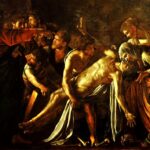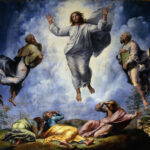Finally, the most important celebration, which defines the heart of our faith.
The Resurrection of the Lord
The Mass of Easter Day (Year A)

Romanelli, Giovanni Francesco; St John and St Peter at the Empty Tomb of Christ; The Fitzwilliam Museum
The Resurrection of Christ is the cornerstone event.
In order to better appreciate its importance, consider this quotation from St. Paul, who clarifies what’s at stake here (1Cor 15, 17-19):
…if Christ has not been raised, your faith is pointless and you have not, after all, been released from your sins.
In addition, those who have fallen asleep in Christ are utterly lost.
If our hope in Christ has been for this life only, we are of all people the most pitiable.
With this, Paul settles the score with those intellectuals who see in Jesus only “one of the great spiritual teachers in history”. Similarly ridiculous and vain are those ideologues who imagine a Revolutionary Christ, a human conduit for social grievances and political (radical) reform.
No, the whole edifice is founded on that empty tomb. Defining the meaning of life, defining what we are. Either pathetic animals lacking even free will, or beings created in the likeness of God, destined to live forever.
There are no more important questions than this: is he really risen?
That’s why you’d expect a unique emphasis, and a great attention to detail, in recounting the events surrounding Jesus’ resurrection and encounters with his followers.
As I mentioned recently, what is striking is the terse style and sometimes confusing (contradictory?) way in which this story is told to us in the New Testament.
For example, the Reading 1 from the Acts of the Apostles says:
This man God raised on the third day and granted that he be visible,
not to all the people, but to us,
the witnesses chosen by God in advance,
who ate and drank with him after he rose from the dead.
Why not to all the people?!? This seems to create quite a difficulty: as a consequence there are only biased witnesses!
And beyond that… We’ve seen, from the account of the Passion, that even outside the circle of the disciples Jesus’ announcement of his own death and resurrection had circulated; for this reason guards were sent to secure the tomb, to prevent the body from being stolen to simulate a miraculous event. This is why the story that arguably is tasked with convincing you of the unthinkable, in fact puts a bug in your ear: maybe the event was staged! Plus I’ve already mentioned a legitimate doubt, recently: the Risen One who appears to disciples and apostles may be instead a different person; that would explain why at first they don’t recognize him… The mistaken identity seems a distinct possibility in the most striking miracles (I gave the example of the blind born man).
On the other hand, the passage I have just quoted speaks of eating and drinking, thus making it clear that one cannot think of an apparition. It reports about something concrete: a real body, a true encounter; the echo of a spontaneous, unadulterated memory is captured. (The echo: it’s not a proof, it’s just a clue.)
But, also thanks to the discrepancies between the Gospels, the question remains: could they not have provided a more complete and convincing account?
Now this is subtle: if I want to convince you of something, and I bring forward a number of specific assertions, how can I differentiate myself from a good liar?
The more details I add, the more suspicious things get. Why do you insist so much on selling me this car, on convincing me that opportunities like this are super rare, that the car is such a beauty, plus it’s almost as good as new, not a scratch, engine recently overhauled…?
The apocryphal gospels (that is to say discarded because evidently written much later and lacking credibility) are just like that: they project ideas and philosophies onto the story, add fantastic details or the style of a novel.
The road to credibility is definitely through something else: not through sensationalist accounts and nice words.
They once asked one of these famous militant atheists, whose name escapes me at the moment… you know, right? I’m talking about one of the stars of “skepticism” (so called) who are continually invited to interviews and debates…
Anyway. They asked this radical atheist, as I was saying, if there was a way, a series of conditions to be met, through which God could convince him of his existence.
And he, evidently having thought about it, conceded with remarkable honesty that no, there was no way to convince him of the existence of God. What could an omnipotent being do, after all? Appear directly, accompanied by great signs and wonders? Address him with a thundering voice from Heaven? Well, for a skeptic any manifestation, however realistic, could be just a hallucination, if not (at least for the most feasible scenarios) the result of an elaborate trick.
No, there is no convincing direct experience if you don’t want to be convinced. Imagine then how convincing a story can be, especially second or third hand, that talks about incredible events never seen before.
So how could God pull this off? Here we’re again touching on a theme I’ve already mentioned before: the secret has all to do with subtlety. There are many criteria of credibility, most being definitely not trivial.
For example: a reconstruction in which there are some discrepancies between the accounts of different witnesses is in itself credible; one in which all the witnesses are perfectly aligned is instead more than suspicious, because it probably reflects a coordination or a rewriting of the accounts by a single person.
We shouldn’t be surprised by some apparent confusion in the story of those hectic hours in which everything happened: the imprecision, the overlapping voices, the conflicting memories are to be expected, if we are dealing with narratives closer to the news, with direct experiences, even though eventually reworked and put in writing over time.
Now, as far as the testimonies of the resurrection are concerned, the first one, dealing with Easter day, is of considerable importance, especially for us. At the same time I imagine that the primitive community, while wanting to know about those fateful moments, found more interest in those episodes in which Christ appears, enters a room with closed doors, eats, has his wounds touched… Much has been said about
the very first, confused, testimony, coming from Magdalene and from women: for the culture of the time and of the Israelites, devoid of credibility precisely because they were women.
Once again: is this how an author would fabricate stories, shooting himself in the foot? No, there must be a reality behind. “Those hysterical females”, someone must have said, are so easily prey to their emotions that they thought they saw angels.
Now one could add: indeed the Gospel of John, coming last, rectifies the situation by inserting the valid testimony of two men: Peter and John.
But once again, an unprejudiced critical analysis of the text leads us to appreciate its verisimilitude. In fact, if John really had the opportunity to invent stories, how could he have chosen the one we got?
To reiterate: for a naive public of easily convinced followers, just the sight of the empty tomb does not say much; the apparitions in which Jesus is physically present are the real deal. For the skeptics of the Areopagus in Athens, who burst into laughter as soon as Paul mentioned resurrection, the fact that the tomb is empty only proves that the body is no longer there, but that would certainly not be the first case of a corpse that was moved to a new burial place, possibly in secret!
Even though it’s true that in the Hellenistic world women were still in a position of inferiority, I find it remarkable that the author – supposed by the critics to be part of a cosmopolitan community, far removed from the Israel of Jesus, now annihilated by the Romans – still retains and indeed reinforces the prejudices typical of a man born into the Law of Israel of the time: he dismisses Mary of Magdala in a few words, without mentioning apparitions to women (because they don’t count anyway).
He then proceeds to narrate what an unprejudiced observer recognizes as a first-person experience. Both for what he says and for what he doesn’t say (and I’ll leave to the shilly-shally experts the privilege of wasting away pages on the doubt that 1. the author of the text, 2. the young disciple who accompanies Peter, and 3. the Apostle John are not all the same person, which instead fits perfectly).
Compared to the typical terseness of the Gospels (papyrus costs money, moreover the message is mostly comprised of easily memorized, instructive formulas, hardly of detailed chronicles) we find a sequence described with significantly more details than necessary: first he runs ahead and arrives at the tomb before Peter; he immediately sees the burial cloths from outside; then he waits for the older Apostle (and group leader) to enter; but as soon as he enters he sees something… and immediately believes in the resurrection of Jesus!
This is not the right occasion to discuss bandages, shrouds and Greek words, also because I’m not competent enough. But the fact remains that he could have explained himself much better, adding maybe just two or three more words! What did he see? What did he see (!) , that he could only notice once inside, looking at the sheets and the shroud, that instantly led him to the belief that Jesus had risen?
We don’t know; some hypothesized that he saw sheets that no longer contained a body, but were still tied, so no human being could have found a way to remove the body without unraveling the bandages; as if Jesus, no longer constrained by the laws of physics, had gone through the material of the cloth.
Whatever the story, once again: this is NOT the way to properly invent fictional stories, leaving everyone perplexed and making the whole system based on a story which is unclear, and which deals only with an indirect sign.
The last Gospel refrains from any significant addition or embellishment, and indeed takes almost a step back.
This is credibility, for those who care to dig deeper.
There’s no need to frown if you don’t like splitting hairs and prefer a simple, direct belief system, without any sophistry.
As already mentioned in previous episodes, faith for us Christians of the information age must necessarily be based on our taking doubts seriously and finding non-trivial answers.
Eventually sincerity pays off, and it prevails, visibly, over the rhetorical gymnastics of the skeptics.
It is after having gone through this path of maturation and analysis that we can then rightly say it…
Yes, this is our belief, Jesus Christ is truly risen!










































